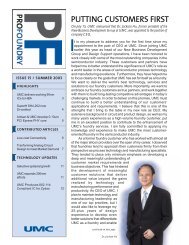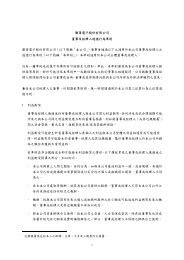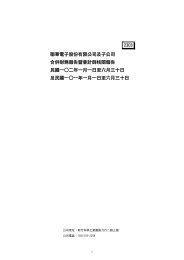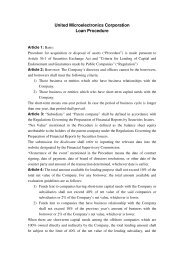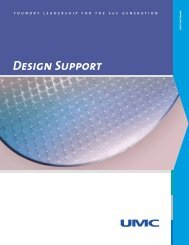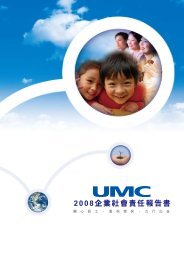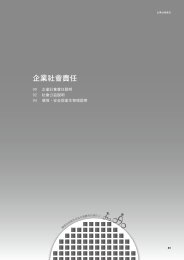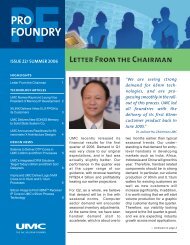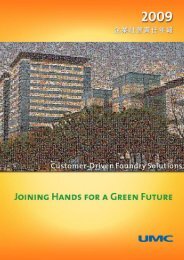Ch2 Sustainable Development - Environment - UMC
Ch2 Sustainable Development - Environment - UMC
Ch2 Sustainable Development - Environment - UMC
- No tags were found...
Create successful ePaper yourself
Turn your PDF publications into a flip-book with our unique Google optimized e-Paper software.
● <strong>Environment</strong>al Management System Overview<br />
High<br />
Management<br />
Level Audit<br />
Check<br />
Policy<br />
Improving<br />
and<br />
Plan<br />
Pollution Prevention<br />
<strong>UMC</strong>’s environmental protection policy explicitly sets the goal<br />
of zero pollution and the mandate to comply with or exceed<br />
environmental regulation requirements or international<br />
standards, in an attempt to become a sustainable green<br />
enterprise. <strong>UMC</strong> has installed various effective pollution control<br />
equipment and a 24-hour central monitoring system. It continues<br />
to conduct annual pollutant tests and builds a dedicated<br />
pollution prevention team pursuant to applicable regulations.<br />
The team is in charge of pollution management and monitoring<br />
to ensure the proper functioning and performance compliance<br />
of all pollution control equipment.<br />
Management Focus in 2011<br />
● Acute Biological Toxicity in Waste Water<br />
Due to the increased awareness of environmental issues and<br />
the enforcement of government regulations, the control of<br />
biological toxicity in effluent water has become a new area of<br />
concern. <strong>UMC</strong>'s pursuit of sustainability motivates it to join<br />
Hi-tech Waste Water Discharge Standards Functional Group<br />
made up by Hsinchu Science Park Administration, various<br />
industrial associations, and Science Park Association. The group<br />
members have conducted evaluations on factors that could<br />
contribute to acute biological toxicity, including NH 3 , TMAH,<br />
H 2 O 2 , electricity conductivity, nano or other substances. <strong>UMC</strong>’s<br />
main task is to conduct an improvement assessment of TMAH,<br />
which is scheduled to finish in 2011. The results will be sent to<br />
Science Park Administration and Functional Group to facilitate<br />
appropriate control measures. <strong>UMC</strong> has built a task force to<br />
minimize the acute biological toxicity in waste water. The task<br />
force focuses on raw materials, pipe diversion, and end-ofpipe<br />
treatment technology. Its effort includes identifying the<br />
toxicity profiles for raw materials, purchasing water quality<br />
testers, identifying sources of waste water toxicity, setting up<br />
a laboratory for daphnia toxicity tests, conducting an analysis<br />
for key factors of biological acute toxicity and a toxicity test on<br />
effluent water, and evaluating the treatment equipment for<br />
biological acute toxicity key factors.<br />
●Waste Contractor Audit Plan<br />
All of <strong>UMC</strong>’s waste is outsourced for treatment by contractors.<br />
In addition to selecting a qualified contractor and best<br />
treatment method, <strong>UMC</strong> also established an annual audit plan<br />
for its waste contractors and conducts regular audits in the<br />
treatment plant.<br />
43



